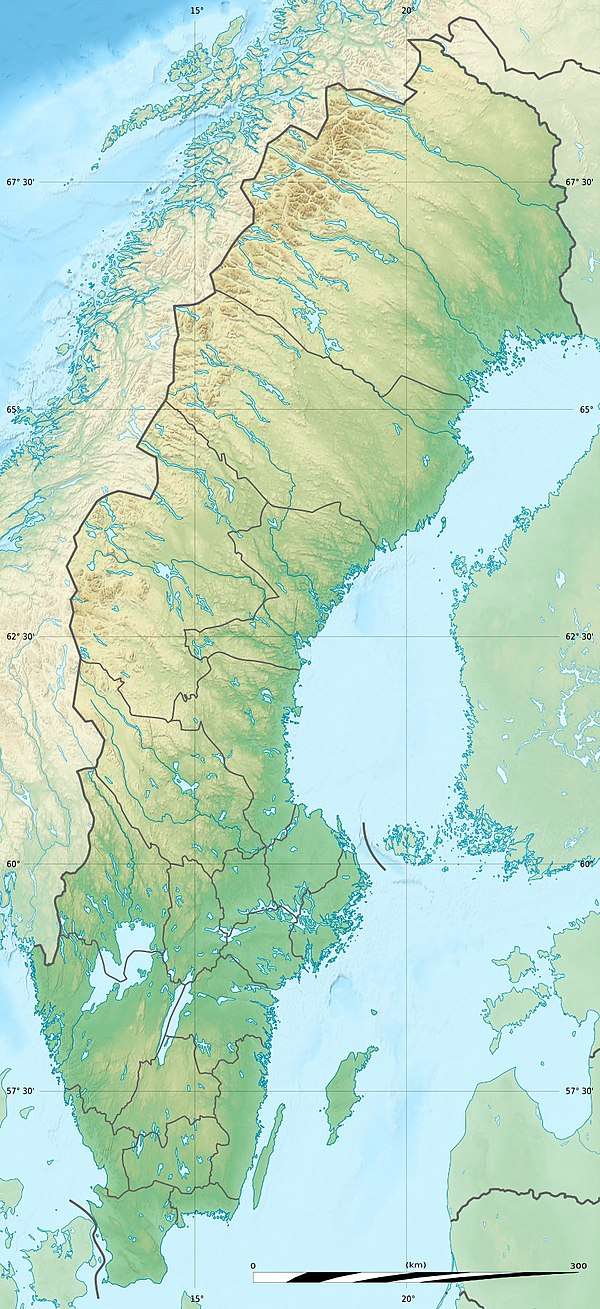FIS Alpine World Ski Championships 2007
The FIS Alpine World Ski Championships 2007 were the 39th FIS Alpine World Ski Championships, held 2–18 February in Åre, Sweden. Åre previously hosted the world championships in 1954, and often hosts late season World Cup events.
 | |
| Host city | Åre, Sweden |
|---|---|
| Events | 11 |
| Opening ceremony | 2 February 2007 |
| Closing ceremony | 18 February 2007 |
| Officially opened by | Carl XVI Gustaf |
| Events at the 2007 FIS Alpine World Ski Championships | ||
|---|---|---|
 | ||
| Combined | men | women |
| Downhill | men | women |
| Giant slalom | men | women |
| Slalom | men | women |
| Super-G | men | women |


The FIS awarded the 2007 event in 2002; other finalists were Lillehammer, Norway, and Val-d'Isère, France, which was later selected to host the 2009 championships.
These were the first world championships to use the "super-combined" format (one run each of downhill and slalom) for the combined event. First run on the World Cup circuit in 2005 at Wengen, the "super-combi" format (SC) made its debut at the Winter Olympics in 2010. The traditional combined format (K) consists of one downhill run and two slalom runs.
Venues
- The World Championships Arena was accessed via the "VM-8an," an 8-passenger hybrid lift installed in 2006.
The races were held on the Gästrappet, Lundsrappet, Störtloppet and VM-Störtloppet slopes. - The medal ceremonies were held at the Medal Plaza at Åre Torg.
- The opening ceremony was held at the Festival Arena, situated outside the Holiday Club Hotel by Lake Åre.
Course information

for the 2007 World Championships
| Race | Start elevation |
Finish elevation |
Vertical drop |
Course length |
Minimum gradient |
Maximum gradient |
Average gradient |
|---|---|---|---|---|---|---|---|
| Downhill – men | 1240 m | 396 m | 844 m | 2.922 km | 7% | 69% | 33% |
| Downhill – women | 1055 | 396 | 659 | 2.236 | 14% | 69% | 31% |
| Super-G – men | 1033 | 396 | 637 | 2.127 | 10% | 69% | 34% |
| Super-G – women | 971 | 396 | 575 | 1.903 | 14% | 69% | 32% |
| Giant slalom – men | 812 | 396 | 416 | 1.308 | 13% | 69% | 35% |
| Giant slalom – women | 796 | 396 | 400 | 1.257 | 17% | 48% | 36% |
| Slalom – men | 615 | 396 | 219 | 0.740 | 19% | 48% | 32% |
| Slalom – women | 582 | 396 | 186 | 0.62 | 14% | 48% | 32% |
| Race | Start elevation |
Finish elevation |
Vertical drop |
Course length |
Minimum gradient |
Maximum gradient |
Average gradient |
|---|---|---|---|---|---|---|---|
| Downhill – men | 4068 ft | 1299 ft | 2769 ft | 1.816 mi. | 7% | 69% | 33% |
| Downhill – women | 3461 | 1299 | 2162 | 1.389 | 14% | 69% | 31% |
| Super-G – men | 3389 | 1299 | 2090 | 1.322 | 10% | 69% | 34% |
| Super-G – women | 3186 | 1299 | 1887 | 1.182 | 14% | 69% | 32% |
| Giant slalom – men | 2664 | 1299 | 1365 | 0.813 | 13% | 69% | 35% |
| Giant slalom – women | 2612 | 1299 | 1313 | 0.781 | 17% | 48% | 36% |
| Slalom – men | 2018 | 1299 | 719 | 0.460 | 19% | 48% | 32% |
| Slalom – women | 1909 | 1299 | 610 | 0.388 | 14% | 48% | 32% |
Opening ceremony
2 February 19:00
- The King of Sweden, Carl XVI Gustaf, officially opened the FIS Alpine World Ski Championships
Men's events
Men's downhill
10 February 12:30. Race postponed to 11 February 10:00 CET due to foggy weather conditions.
| Medal | Name | Nation | Time | Diff. |
|---|---|---|---|---|
| Aksel Lund Svindal | 1:44.68 | |||
| Jan Hudec | 1:45.40 | +0.72 | ||
| Patrik Järbyn | 1:45.65 | +0.97 |
Men's super-G
Originally planned for 3 February 12:30; postponed to 5 February due to wind conditions.
Race was postponed for a second time, to 6 February 10:00 CET.[1]
| Medal | Name | Nation | Time | Diff. |
|---|---|---|---|---|
| Patrick Staudacher | 1:14.30 | |||
| Fritz Strobl | 1:14.62 | +0.32 | ||
| Bruno Kernen | 1:14.92 | +0.62 |
Men's giant slalom
Qualification: 12 February 10:00/13:30
Final: 14 February 10:00/13:00
| Medal | Name | Nation | Time | Diff. |
|---|---|---|---|---|
| Aksel Lund Svindal | 2:19.64 | |||
| Daniel Albrecht | 2:20.12 | +0.48 | ||
| Didier Cuche | 2:20.56 | +0.92 |
Men's slalom
Qualification: 15 February 10:00/13:30
Final: 17 February 10:00/13:00
| Medal | Name | Nation | Time | Diff. |
|---|---|---|---|---|
| Mario Matt | 1:57.33 | |||
| Manfred Mölgg | 1:59.14 | +1.81 | ||
| Jean-Baptiste Grange | 1:59.54 | +2.21 |
Men's super combined
8 February 12:30/16:00
| Medal | Name | Nation | Time | Diff. |
|---|---|---|---|---|
| Daniel Albrecht | 2:28.99 | |||
| Benjamin Raich | 2:29.07 | +0.08 | ||
| Marc Berthod | 2:29.23 | +0.24 |
Women's events
Women's downhill
11 February 12:30
| Medal | Name | Nation | Time | Diff. |
|---|---|---|---|---|
| Anja Pärson | 1:26.89 | |||
| Lindsey C. Kildow | 1:27.29 | +0.40 | ||
| Nicole Hosp | 1:27.37 | +0.48 |
Women's super-G
Originally planned for 4 February 12:30; postponed to 6 February due to wind conditions.[2]
| Medal | Name | Nation | Time | Diff. |
|---|---|---|---|---|
| Anja Pärson | 1:18.85 | |||
| Lindsey C. Kildow | 1:19.17 | +0.32 | ||
| Renate Götschl | 1:19.38 | +0.53 |
Women's giant slalom
13 February 17:00/20:00
| Medal | Name | Nation | Time | Diff. |
|---|---|---|---|---|
| Nicole Hosp | 2:31.72 | |||
| Maria Pietilä-Holmner | 2:32.57 | + 0.85 | ||
| Denise Karbon | 2:32.69 | + 0.97 |
Women's slalom
16 February 17:00/20:00
| Medal | Name | Nation | Time | Diff. |
|---|---|---|---|---|
| Šárka Záhrobská | 1:43.91 | |||
| Marlies Schild | 1:44.02 | +0.11 | ||
| Anja Pärson | 1:44.07 | +0.16 |
Women's super combined
9 February 12:30/16:00
| Medal | Name | Nation | Time | Diff. |
|---|---|---|---|---|
| Anja Pärson | 1:57.69 | |||
| Julia Mancuso | 1:58.50 | +0.81 | ||
| Marlies Schild | 1:58.54 | +0.85 |
Team event
Nations team event
18 February 10:00/13:00
This competition was part of the World Championships for the second time. Six athletes from each country, including at least two men and two women, compete in a total of four super-G and four slalom runs. Each country sends one athlete into each run, alternating between men and women. The placings of all eight competitions are added, and the country with the lowest number wins. If an athlete doesn't finish the run, gets disqualified or scores a time worse than 108% of the winning time, an extra penalty is incurred. If an athlete doesn't start, an even greater penalty is incurred.
| Medal | Name | Nation | SG1 | SG2 | SG3 | SG4 | SL1 | SL2 | SL3 | SL4 | Total |
|---|---|---|---|---|---|---|---|---|---|---|---|
|
Renate Götschl |
1 | 1 | 1 | 2 | 4 | 4 | 1 | 4 | 18 | ||
|
Anna Ottosson |
4 | 8 | 4 | 7 | 1 | 2 | 2 | 5 | 33 | ||
|
Sandra Gini |
11 | 3 | 2 | 1 | 2 | 5 | 4 | 11 | 39 | ||
Medal table
| Place | Nation | Total | |||
|---|---|---|---|---|---|
| 1 | 3 | 3 | 3 | 9 | |
| 2 | 3 | 2 | 2 | 7 | |
| 3 | 2 | 0 | 0 | 2 | |
| 4 | 1 | 1 | 4 | 6 | |
| 5 | 1 | 1 | 1 | 3 | |
| 6 | 1 | 0 | 0 | 1 | |
| 7 | 0 | 3 | 0 | 3 | |
| 8 | 0 | 1 | 0 | 1 | |
| 9 | 0 | 0 | 1 | 1 |
Participating nations
60 nations participated: (number of athletes in parentheses)
|
|
References
- http://www.are2007.com/parser.php?did=2007:4583%5B%5D
- "Archived copy". Archived from the original on 28 September 2007. Retrieved 4 February 2007.CS1 maint: archived copy as title (link)
- Are 2007.com – official site
- FIS-ski.com – results – 2007 World Championships – Åre, Sweden
- FIS-ski.com – results – World Championships
- Ski-db.com – results – 2007 Aare
- wm07.blogspot.com – a list of links related to the championships